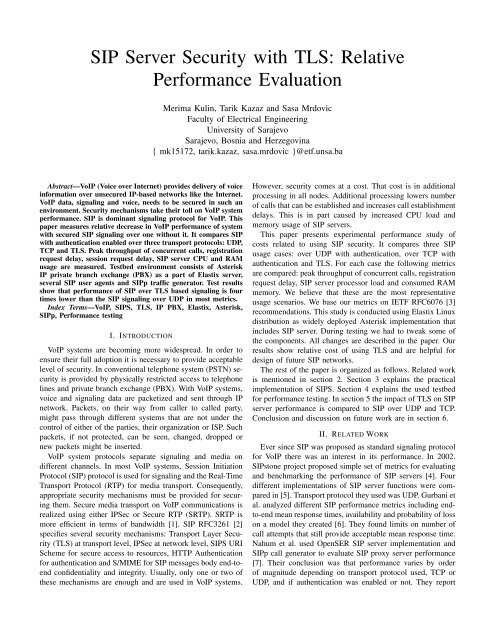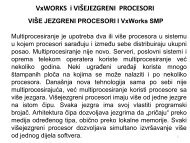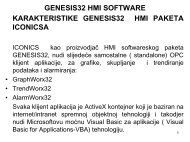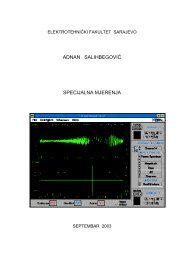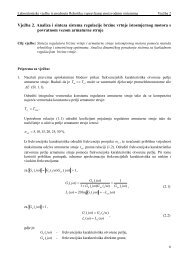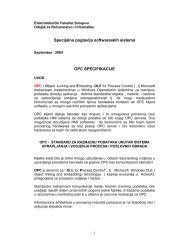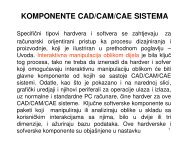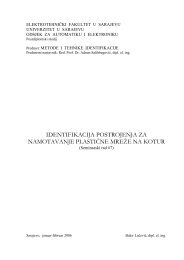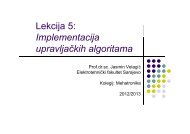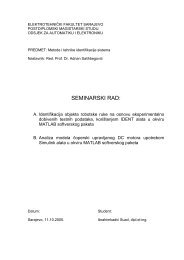SIP Server Security with TLS: Relative Performance Evaluation
SIP Server Security with TLS: Relative Performance Evaluation
SIP Server Security with TLS: Relative Performance Evaluation
Create successful ePaper yourself
Turn your PDF publications into a flip-book with our unique Google optimized e-Paper software.
<strong>SIP</strong> <strong>Server</strong> <strong>Security</strong> <strong>with</strong> <strong>TLS</strong>: <strong>Relative</strong><br />
<strong>Performance</strong> <strong>Evaluation</strong><br />
Merima Kulin, Tarik Kazaz and Sasa Mrdovic<br />
Faculty of Electrical Engineering<br />
University of Sarajevo<br />
Sarajevo, Bosnia and Herzegovina<br />
{ mk15172, tarik.kazaz, sasa.mrdovic }@etf.unsa.ba<br />
Abstract—VoIP (Voice over Internet) provides delivery of voice<br />
information over unsecured IP-based networks like the Internet.<br />
VoIP data, signaling and voice, needs to be secured in such an<br />
environment. <strong>Security</strong> mechanisms take their toll on VoIP system<br />
performance. <strong>SIP</strong> is dominant signaling protocol for VoIP. This<br />
paper measures relative decrease in VoIP performance of system<br />
<strong>with</strong> secured <strong>SIP</strong> signaling over one <strong>with</strong>out it. It compares <strong>SIP</strong><br />
<strong>with</strong> authentication enabled over three transport protocols: UDP,<br />
TCP and <strong>TLS</strong>. Peak throughput of concurrent calls, registration<br />
request delay, session request delay, <strong>SIP</strong> server CPU and RAM<br />
usage are measured. Testbed environment consists of Asterisk<br />
IP private branch exchange (PBX) as a part of Elastix server,<br />
several <strong>SIP</strong> user agents and <strong>SIP</strong>p traffic generator. Test results<br />
show that performance of <strong>SIP</strong> over <strong>TLS</strong> based signaling is four<br />
times lower than the <strong>SIP</strong> signaling over UDP in most metrics.<br />
Index Terms—VoIP, <strong>SIP</strong>S, <strong>TLS</strong>, IP PBX, Elastix, Asterisk,<br />
<strong>SIP</strong>p, <strong>Performance</strong> testing<br />
I. INTRODUCTION<br />
VoIP systems are becoming more widespread. In order to<br />
ensure their full adoption it is necessary to provide acceptable<br />
level of security. In conventional telephone system (PSTN) security<br />
is provided by physically restricted access to telephone<br />
lines and private branch exchange (PBX). With VoIP systems,<br />
voice and signaling data are packetized and sent through IP<br />
network. Packets, on their way from caller to called party,<br />
might pass through different systems that are not under the<br />
control of either of the parties, their organization or ISP. Such<br />
packets, if not protected, can be seen, changed, dropped or<br />
new packets might be inserted.<br />
VoIP system protocols separate signaling and media on<br />
different channels. In most VoIP systems, Session Initiation<br />
Protocol (<strong>SIP</strong>) protocol is used for signaling and the Real-Time<br />
Transport Protocol (RTP) for media transport. Consequently,<br />
appropriate security mechanisms must be provided for securing<br />
them. Secure media transport on VoIP communications is<br />
realized using either IPSec or Secure RTP (SRTP). SRTP is<br />
more efficient in terms of bandwidth [1]. <strong>SIP</strong> RFC3261 [2]<br />
specifies several security mechanisms: Transport Layer <strong>Security</strong><br />
(<strong>TLS</strong>) at transport level, IPSec at network level, <strong>SIP</strong>S URI<br />
Scheme for secure access to resources, HTTP Authentication<br />
for authentication and S/MIME for <strong>SIP</strong> messages body end-toend<br />
confidentiality and integrity. Usually, only one or two of<br />
these mechanisms are enough and are used in VoIP systems.<br />
However, security comes at a cost. That cost is in additional<br />
processing in all nodes. Additional processing lowers number<br />
of calls that can be established and increases call establishment<br />
delays. This is in part caused by increased CPU load and<br />
memory usage of <strong>SIP</strong> servers.<br />
This paper presents experimental performance study of<br />
costs related to using <strong>SIP</strong> security. It compares three <strong>SIP</strong><br />
usage cases: over UDP <strong>with</strong> authentication, over TCP <strong>with</strong><br />
authentication and <strong>TLS</strong>. For each case the following metrics<br />
are compared: peak throughput of concurrent calls, registration<br />
request delay, <strong>SIP</strong> server processor load and consumed RAM<br />
memory. We believe that these are the most representative<br />
usage scenarios. We base our metrics on IETF RFC6076 [3]<br />
recommendations. This study is conducted using Elastix Linux<br />
distribution as widely deployed Asterisk implementation that<br />
includes <strong>SIP</strong> server. During testing we had to tweak some of<br />
the components. All changes are described in the paper. Our<br />
results show relative cost of using <strong>TLS</strong> and are helpful for<br />
design of future <strong>SIP</strong> networks.<br />
The rest of the paper is organized as follows. Related work<br />
is mentioned in section 2. Section 3 explains the practical<br />
implementation of <strong>SIP</strong>S. Section 4 explains the used testbed<br />
for performance testing. In section 5 the impact of <strong>TLS</strong> on <strong>SIP</strong><br />
server performance is compared to <strong>SIP</strong> over UDP and TCP.<br />
Conclusion and discussion on future work are in section 6.<br />
II. RELATED WORK<br />
Ever since <strong>SIP</strong> was proposed as standard signaling protocol<br />
for VoIP there was an interest in its performance. In 2002.<br />
<strong>SIP</strong>stone project proposed simple set of metrics for evaluating<br />
and benchmarking the performance of <strong>SIP</strong> servers [4]. Four<br />
different implementations of <strong>SIP</strong> server functions were compared<br />
in [5]. Transport protocol they used was UDP. Gurbani et<br />
al. analyzed different <strong>SIP</strong> performance metrics including endto-end<br />
mean response times, availability and probability of loss<br />
on a model they created [6]. They found limits on number of<br />
call attempts that still provide acceptable mean response time.<br />
Nahum et al. used OpenSER <strong>SIP</strong> server implementation and<br />
<strong>SIP</strong>p call generator to evaluate <strong>SIP</strong> proxy server performance<br />
[7]. Their conclusion was that performance varies by order<br />
of magnitude depending on transport protocol used, TCP or<br />
UDP, and if authentication was enabled or not. They report
throughput of hundreds to thousands operations per second.<br />
Interesting findings were reported by [8]. They showed that<br />
principal reason for OpenSER inferior performance using TCP<br />
instead of UDP is server design. They argue that performance<br />
using TCP could be made competitive to performance using<br />
UDP <strong>with</strong> improvements on OpenSER architecture. In order<br />
to provide a standard set of common metrics that will allow<br />
interoperable performance measurements IETF recently issued<br />
RFC6076 devoted to <strong>SIP</strong> performance metrics [3]. Voznak<br />
at al. focused their research on creating a methodology that<br />
would allow administrators to precisely measure the <strong>SIP</strong><br />
<strong>Server</strong> performance and compare it to other software and<br />
hardware platform [9]. Their work resulted in best practice<br />
document for <strong>SIP</strong> performance evaluation [10]. An interesting<br />
branch of research of <strong>SIP</strong> performance is focused on overload<br />
conditions. In order for <strong>SIP</strong> to be used effectively in production<br />
environment it has to be able to handle overload condition<br />
gracefully. Papers by Shen et al. [11], Hilt and Widjaja [12],<br />
Noel and Johnson [13], and Abdelal and Matragi [14] led to<br />
IETF RFC6357 on <strong>SIP</strong> overload control [15].<br />
SSL/<strong>TLS</strong> adds a layer between application and transport<br />
layer. This layer performs cryptographic operations and it<br />
increases processing time. Cost of <strong>TLS</strong> processing was subject<br />
of [16]. Their conclusion was that tested Web servers were<br />
couple of orders of magnitude slower when serving pages<br />
over <strong>TLS</strong>. Another paper [17] analyzed architectural impact<br />
of SSL. They found that SSL increases computational cost<br />
of the transactions by a factor of 5-7. Zhao et al. provided<br />
detailed analysis of various cryptographic operations in SSL<br />
[18]. They showed that major overhead incurred during SSL<br />
processing lies in the session negotiation phase and about 70%<br />
of the total processing time of an HTTPS transaction is spent<br />
in SSL processing. Measurements made by Coarfa et al. show<br />
that RSA computations are the most expensive of all <strong>TLS</strong><br />
operations and count for 20 to 58% time of web server [19].<br />
All above papers analyzed influence of SSL/<strong>TLS</strong> on web<br />
traffic and web servers. Influence of <strong>TLS</strong> on <strong>SIP</strong> server<br />
performance was thoroughly tested in [20]. They compared<br />
<strong>SIP</strong> over <strong>TLS</strong> <strong>with</strong> <strong>SIP</strong> over TCP and UDP. Their results<br />
showed that <strong>SIP</strong> authorization has the biggest impact on total<br />
cost while impact of SSL was rather small. It is different from<br />
latter results by other researchers and might have something<br />
to do <strong>with</strong> used hardware and software and rather small<br />
volume of calls, 21 calls per second. Results of simulation that<br />
measured <strong>SIP</strong> call setup delay of different security protocols<br />
(<strong>TLS</strong>, D<strong>TLS</strong> and IPSec) using different transport protocols<br />
(UDP, TCP and SCTP) showed that this delay doubles for<br />
<strong>TLS</strong> compared to no <strong>SIP</strong> security scenario [21]. A possible<br />
issue <strong>with</strong> results might be that they are product of simulation<br />
and not a test of a real system. Test on real system was<br />
performed by Sureshkumar and Dutta [22]. They measured<br />
Call setup time, Mean number of calls, Memory utilization,<br />
CPU utilization and queue size for four different scenarios:<br />
UDP and TCP <strong>with</strong> no security, <strong>TLS</strong>-authentication and <strong>TLS</strong>encryption.<br />
They report increase of all measured parameters<br />
for <strong>TLS</strong> vs. UDP to be less than 100% and even smaller<br />
increase for <strong>TLS</strong> vs. TCP. The most relevant is work of<br />
Shen et al. [23]. They did a very thorough testing. First,<br />
they had four different deployment models: proxy chain,<br />
outbound proxy, inbound proxy and local proxy. In addition<br />
they tested various combinations of transport protocols (UDP,<br />
TCP, <strong>TLS</strong> <strong>with</strong> 3DES and <strong>TLS</strong> <strong>with</strong> AES) <strong>with</strong> and <strong>with</strong>out<br />
authentication, for a total of eight. Further, they tested different<br />
<strong>TLS</strong> configurations (e.g. <strong>with</strong> or <strong>with</strong>out mutual authentication<br />
or session resumption). Their testbed consisted of Open<strong>SIP</strong>,<br />
OpenSSL on Linux <strong>with</strong> Intel-based server hardware. That<br />
paper provides detail analysis of costs on CPU and its causes.<br />
They state that using <strong>TLS</strong> can reduce performance by up<br />
to a factor of 17 compared to the typical case of <strong>SIP</strong>-over-<br />
UDP. It must be pointed out that this factor is for the case<br />
of <strong>TLS</strong> <strong>with</strong> mutual authentication compared to UDP <strong>with</strong>out<br />
authentication. We consider fewer cases that we believe are<br />
more relevant but we test for more <strong>SIP</strong> to performance metrics<br />
as per [3]. In fact, we measured the performance of <strong>SIP</strong><br />
server by monitoring the processor load and consumed RAM<br />
memory. In comparison to the other mentioned papers, we<br />
used Elastix as possibly the most powerful packaging of<br />
a very powerful and popular telephony development toolkit,<br />
the Asterisk server. As opposed to [23] we measured<br />
simultaneously the performance of <strong>SIP</strong> protocol. This was<br />
evaluated using RRD and SRD metrics as defined in [3].<br />
III. IMPLEMENTING SECURE VOIP COMMUNICATION<br />
The key aspect of secure VoIP communication is the security<br />
of the signaling path, which is provided by <strong>SIP</strong> protocol.<br />
The main components for securing <strong>SIP</strong> communication are:<br />
confidentiality and integrity of signaling messages and authentication<br />
of parties. Several <strong>SIP</strong> security mechanisms are<br />
specified in [4] as mentioned before. <strong>TLS</strong> is a widespread<br />
and well-known transport protocol for secure communication.<br />
It provides confidentiality and integrity of the transmission<br />
channel for data exchanged between applications at higher<br />
level. <strong>TLS</strong> makes use of X.509 certificates to associate a<br />
public key <strong>with</strong> the certificate subject. This relationship is<br />
confirmed by the digital signature of the certificate authority<br />
(CA), which involves public key cryptography. <strong>TLS</strong> allows<br />
both entities in a communication link to authenticate each<br />
other. However, <strong>TLS</strong> <strong>with</strong> mutual authentication is impractical<br />
and a challenging implementation due to problems <strong>with</strong> key<br />
distribution. In [23] it is shown that using <strong>TLS</strong> <strong>with</strong> mutual<br />
authentication can reduce performance by up to a factor of<br />
17 compared to <strong>SIP</strong>-over-UDP. Further, <strong>TLS</strong> support is not<br />
yet fully implemented in all currently available <strong>SIP</strong> UAC<br />
softphone solutions. Some of them <strong>with</strong> <strong>TLS</strong> support are:<br />
Blink, Bria, Linphone, Micro<strong>SIP</strong> and Yate. Not all support<br />
mutual authentication using client certificates. For this reasons,<br />
in our proposed VoIP security approach we used HTTP digest<br />
authentication scheme for verifying the identity of users and<br />
performing message authentication. On the other side, <strong>with</strong><br />
<strong>TLS</strong> clients authenticate the server using the server’s public<br />
key associated <strong>with</strong> the server’s certificate. This assured <strong>SIP</strong><br />
mutual authentication. <strong>SIP</strong> message privacy protection is en-
abled using encryption <strong>with</strong> keys that are exchanged during<br />
<strong>TLS</strong> handshake procedure. <strong>TLS</strong> message integrity is ensured<br />
by sending additionally a keyed digest of the original message<br />
using a secret key shared between the sender and receiver.<br />
This paper is focused on relative performance evaluation<br />
of <strong>SIP</strong> server in local proxy operation mode when using secured<br />
<strong>SIP</strong> message transport (<strong>TLS</strong>) over non-secured transport<br />
protocols (TCP/UDP).<br />
IV. EXPERIMENT SETUP<br />
In order to perform performance testing of <strong>SIP</strong> server and<br />
measure some basic <strong>SIP</strong> performance metrics in different<br />
cases, when using <strong>SIP</strong>/UDP, <strong>SIP</strong>/TCP and <strong>SIP</strong>/<strong>TLS</strong>, we used<br />
the testbed shown in Fig. 1. Our testing platform consisted of<br />
three main elements: a <strong>SIP</strong> server, a traffic generator and a<br />
monitoring system. In addition, we used a DNS server based<br />
on bind9 software that translated the domain name of the<br />
Elastix server (centrala1.ntpmng.com) into its IP address.<br />
All software we used is freely-available and Open Source.<br />
We installed the particular software on virtual machines using<br />
VirtualBox virtualization tool. Below we describe in detail the<br />
hardware and software used in our experiments.<br />
A. <strong>SIP</strong> server software<br />
We used the latest stable release of Elastix server, 64-bit version<br />
of Elastix 2.3.0, as <strong>SIP</strong> server. Elastix project begun as a<br />
call report interface for Asterisk but today it includes multiple<br />
features and functionalities (VoIP, Mail server, IM server, Fax<br />
server etc.) all realized through Open Source tools compiled<br />
together. However, we used the IP PBX functionality. The core<br />
IP PBX represented Asterisk. The currently integrated version<br />
of Asterisk in Elastix 2.3.0 is Asterisk 1.8.11.0-0, which is<br />
a Long Term Support (LTS) release. Asterisk is built on<br />
loadable components called modules. All of them are loaded<br />
based on the /etc/asterisk/modules.conf file. For example,<br />
Asterisk uses res_srtp module for SRTP support. Asterisk<br />
supports <strong>TLS</strong> for <strong>SIP</strong> signaling encryption and SRTP for media<br />
streams encryption. For this purpose the packages OpenSSL<br />
(openssl-devel on CentOS) and LibSRTP (libsrtp-devel<br />
on CentOS) must be installed. Elastix 2.3.0 includes both of<br />
them and the RTSP module res_srtp is also compiled and installed.<br />
The main configuration files are extensions.conf and<br />
sip.conf, which include variety of other files, all located in<br />
the /etc/asterisk/ directory. The file sip_additional.conf<br />
includes information about user extensions. We created 2000<br />
user <strong>SIP</strong> peers, 1000 per side. This was effectively done by<br />
importing a .csv file through Elastix Web User Interface.<br />
The default transport protocol used in Elastix server is UDP.<br />
We used target options in the sip.conf file to enable <strong>SIP</strong><br />
over TCP, and <strong>SIP</strong> over <strong>TLS</strong>. For TCP support the options<br />
tcpenable and tcpbindaddr were set. Analogous, the global<br />
options tlsenable and tlsbindaddr were set for <strong>TLS</strong> support.<br />
Additionally, in the sip_additional.conf file for every user<br />
extension the transport option was set to tcp or tls, depending<br />
of the testing scenario. The next step was to generate a selfsigned<br />
certificate. This was done using the OpenSSL tool. A<br />
Subnet: 192.168.1.0<br />
Subnet mask: 255.255.255.0<br />
Broadcast address: 192.168.1.255<br />
Default gateway: 192.168.1.1<br />
Asterisk Extensions: 11000-12999<br />
<strong>SIP</strong>p UAC<br />
Ext. 11xxx<br />
DNS server<br />
192.168.1.5<br />
192.168.1.1<br />
<strong>SIP</strong>S<br />
Figure 1.<br />
Agent<br />
centrala1.ntpmng.com<br />
IP PBX<br />
SNMP,<br />
Zabbix<br />
<strong>SIP</strong>S<br />
Testbed diagram<br />
Manager<br />
Zabbix NMS<br />
<strong>SIP</strong>p UAS<br />
Ext. 12xxx<br />
CA certificate (ca.crt) and a server certificate (server.pem)<br />
were generated. The ca.crt connects the identity of the CA<br />
<strong>with</strong> its public key that the client uses to validate the server’s<br />
certificate. Finally, we needed to point Elastix to the CA and<br />
server certificate location using tlscertfile and tlscafile<br />
options in the sip.conf file, respectively, after we had moved<br />
both certificates to the appropriate locations in Elastix server.<br />
The default path of the files is /var/lib/asterisk/keys/.<br />
Lastly, the certificate authority (ca.crt) was attached to the<br />
client machines, so they could validate the server certificate.<br />
We installed Elastix server on a Guest OS CentOS 5.7 (File<br />
Descriptor Limit=1024, Stack Size Limit=10240) <strong>with</strong>:<br />
• 4x Virtual x64 Processor Core @ 2.4 GHz,<br />
• 3430 MB Virtual RAM.<br />
B. Traffic generator software<br />
For the purpose of <strong>SIP</strong> server performance testing we<br />
needed to generate hundreds of calls. It is difficult to achieve<br />
quite a few established calls using softphones on both sides on<br />
single physical machines. Consequently, we used a <strong>SIP</strong> load<br />
generator, called <strong>SIP</strong>p (version 2.3 built <strong>with</strong> <strong>TLS</strong> support),<br />
to simulate client sessions [24]. <strong>SIP</strong>p enabled the generation<br />
of high <strong>SIP</strong> load to run performance tests and also the measurement<br />
of delay parameters of individual <strong>SIP</strong> calls. <strong>SIP</strong> call<br />
flows are defined in XML scenario files which are loaded when<br />
running <strong>SIP</strong>p. <strong>SIP</strong>p supports TCP and UDP over multiple<br />
sockets and advanced features like <strong>TLS</strong>, <strong>SIP</strong> authentication,<br />
UDP retransmissions and <strong>SIP</strong> header field injection from<br />
external CSV file to emulate live users. <strong>SIP</strong>p also allows<br />
generation of RTP traffic, but does not support SRTP. On<br />
the <strong>SIP</strong> UAC side we used multi socket mode in all cases<br />
UDP/TCP/<strong>TLS</strong> to emulate user agents calling a <strong>SIP</strong> server. For<br />
each new call a new socket was opened. UDP retransmission<br />
followed the mechanism described in [2].<br />
Since we wanted to test the performance of a relatively<br />
busy <strong>SIP</strong> server, we needed to generate 1000 client sessions<br />
on the calling party side. However, during testing we noticed<br />
that <strong>SIP</strong>p is capable of creating about 250 simultaneous calls.
Therefore, due to the software limitations of <strong>SIP</strong>p we needed<br />
to install 4 virtual machines each running a <strong>SIP</strong>p UAC to<br />
achieve 1000 calls per second. Another issue <strong>with</strong> <strong>SIP</strong>p was<br />
that when started it could act only as UAC or UAS, but not<br />
both at the same time on the same machine. The problem<br />
became clear after taking a look at the <strong>SIP</strong>p call flow diagram<br />
of our desired testing scenario on the <strong>SIP</strong> UAS side shown<br />
in Fig. 2. The calling client party acted as classical as <strong>SIP</strong><br />
UAC during register procedure and call setup procedures. It<br />
sent <strong>SIP</strong> requests and waited for the corresponding answers.<br />
However, it is required that the called party is registered <strong>with</strong><br />
Elastix server in order to be able to accept calls. Considering<br />
Fig. 2 it is obvious that the called party must simultaneously<br />
act as <strong>SIP</strong> UAC (when sending <strong>SIP</strong> REGISTER) and <strong>SIP</strong> UAS<br />
(when receiving <strong>SIP</strong> requests from UAC). Running a separate<br />
UAC-mode script for registering the <strong>SIP</strong> called parties is useful<br />
only in UDP testing mode. In TCP and <strong>TLS</strong> mode after the<br />
registration script is executed a TCP message <strong>with</strong> set FIN<br />
flag is sent for each simulated client session. This caused<br />
Elastix server to discard the registrations. For this purpose,<br />
some VoIP platforms were useful (Yate, Linphone or PJSUA)<br />
but were limited in terms of ineffective user accounts creation<br />
or speed of processing incoming calls. Fortunately, modifying<br />
the <strong>SIP</strong>p source code allowed us to run <strong>SIP</strong>p in a mixture<br />
scenario of UAC and UAS mode concurrently. At [25] there<br />
is a patch that was created by Matthew Briggs for this purpose.<br />
It has to be mentioned that the first, UAC mode, script had run<br />
long enough to enable finishing the execution of the second,<br />
UAS, script. This was achieved by setting appropriate <br />
message command at the end of the first script.<br />
Below are the characteristics of the used <strong>SIP</strong>p UAC and<br />
<strong>SIP</strong>p UAC/UAS virtual machines both <strong>with</strong> 20 GB HDD, File<br />
Descriptor Limit 1024 and Stack Size Limit 8192.<br />
<strong>SIP</strong>p<br />
UAC VM:<br />
• Guest OS Ubuntu 12.04 x64 <strong>Server</strong> Edition,<br />
• 2x Virtual x64 Processor Core @ 3.4 GHz,<br />
• 1024 MB Virtual RAM.<br />
<strong>SIP</strong>p<br />
UAC/UAS VM:<br />
• Guest OS Ubuntu 12.04 x64 <strong>Server</strong> Edition,<br />
• 4x Virtual x64 Processor Core @ 2.27 GHz,<br />
• 2452 MB Virtual RAM.<br />
C. Monitoring system software<br />
In Fig. 1 the three principal components of network management<br />
architecture can be identified: a managing entity (the<br />
manager), the managed devices called agent (Elastix server)<br />
and a network management protocol. The function of the<br />
managing entity was realized by Zabbix [26] network monitoring<br />
application. Zabbix controlled the collection, processing,<br />
analysis and display of network management information in<br />
real-time. The values about the processor load and consumed<br />
RAM were retrieved using the protocol specific for Zabbix<br />
over TCP, whereas the number of concurrent calls using the<br />
Simple Network Management Protocol (SNMP). Accordingly,<br />
we installed and configured Zabbix agent and SNMP agent on<br />
RRD<br />
SRD<br />
Pause<br />
the<br />
script<br />
<strong>SIP</strong>p UAC Elastix IP-PBX <strong>SIP</strong>p UAC/UAS<br />
Figure 2.<br />
REGISTER<br />
401 Unauthorized<br />
REGISTER/<br />
WWW-Authenticate<br />
200 OK<br />
INVITE<br />
401 Unauthorized<br />
ACK<br />
INVITE/<br />
WWW-Authenticate<br />
180 Ringing<br />
200 OK<br />
401 Unauthorized<br />
200 OK<br />
INVITE<br />
ACK ACK<br />
BYE<br />
200 OK<br />
RTP session<br />
REGISTER<br />
REGISTER/<br />
WWW-Authenticate<br />
180 Ringing<br />
200 OK<br />
BYE<br />
200 OK<br />
UAC<br />
mode<br />
UAS<br />
mode<br />
MSC diagram for testing XML scenario<br />
Elastix server and added Asterisk and Digium MIB files into<br />
/usr/share/snmp/mibs directory on Elastix server.<br />
D. Hardware and connectivity<br />
The Elastix server hardware had Intel Core i5 2.4GHz<br />
processor <strong>with</strong> 6GB RAM and 500GB hard drives. All 4 <strong>SIP</strong>p<br />
UAC virtual machines were on the same host machine that had<br />
Intel Core i7 3.4GHz processor <strong>with</strong> 8GB RAM and 720GB<br />
hard drives. <strong>SIP</strong>p UAC/UAS virtual machine was on host<br />
machine that has Intel Core i3 2.27GHz processor <strong>with</strong> 4GB<br />
RAM and 320GB hard drives. The devices were connected<br />
through 1 Gbit Ethernet cable <strong>with</strong> UBIQUITI AirRouter.<br />
V. PERFORMANCE EVALUATION<br />
The goal of our experiment was to analyze the ability<br />
of VoIP PBX Elastix server to handle multiple simultaneous<br />
registrations and call setups. We performed performance evaluation<br />
through testing hardware utilization of Elastix server<br />
during the <strong>SIP</strong> scenario defined in Fig. 2 as well as some<br />
standard metrics for measuring and reporting <strong>SIP</strong> performance.<br />
It is important to emphasize that our test scenario did not<br />
involve the exchange of media (RTP) traffic, because our<br />
goal was to test the impact of <strong>SIP</strong> signaling protocol over<br />
different transport protocols on the performance of VoIP PBX<br />
server and VoIP service. Because of this after a call was<br />
established in the <strong>SIP</strong>p scenario script we set a pause so that<br />
the call remained active for some time. Processor load and consumed<br />
RAM measuring was achieved using Zabbix network<br />
monitoring system as described in the previous section. <strong>SIP</strong><br />
performance was evaluated using the proposed methodology
Session Request Delay (ms)<br />
Registration Request Delay (ms)<br />
Throughput (cps)<br />
for testing and benchmarking <strong>SIP</strong> infrastructure in RFC6076<br />
[3]. The metrics we chose for testing are: RRD (Registration<br />
Request Delay) and SRD (Session Request Delay) [10]. RRD<br />
is a measurement of delay in responding to a UA REGISTER<br />
request. SRD is the time interval from when the first bit of the<br />
initial INVITE message is sent by the originating user agent<br />
to the intended destination agent, until the last bit of the first<br />
provisional response is received (180 Ringing). Both, RRD and<br />
SRD are illustrated on Fig. 2. We measured RRD and SRD as<br />
specified in [3] at the originating <strong>SIP</strong>p UA just for successful<br />
session setup. This was achieved using the ability of <strong>SIP</strong>p to<br />
dynamically display statistics about running tests, including<br />
response times. For this purpose we specified the start (<strong>with</strong><br />
start_rtd attribute) and the endpoint for two counters (<strong>with</strong><br />
rtd attribute), each one for RRD and SRD computation.<br />
To dump the response times in an external .csv file the<br />
-trace_rtt option was additionally used at the <strong>SIP</strong>p command<br />
line. This allowed us to effectively analyze and process the<br />
obtained results. Results for every single parallel <strong>SIP</strong> session<br />
that are collected from all machines from which we generated<br />
traffic were arithmetically averaged and as such are presented<br />
in the following section.<br />
A. Results<br />
Depending on the transport protocols over which <strong>SIP</strong> signaling<br />
is established, each figure has three corresponding<br />
characteristic curves. For each of the protocols we used the<br />
same scenario, but <strong>with</strong> different load level, or more precisely<br />
<strong>with</strong> different rates for generating concurrent calls. Each tested<br />
configuration regardless of the transport protocol has <strong>SIP</strong><br />
authentication enabled. During testing we used <strong>TLS</strong> <strong>with</strong> <strong>TLS</strong>-<br />
AES chipper suite. The call generation rates were increased<br />
until we noticed that <strong>SIP</strong>p enters in saturation. Saturation<br />
occurs when <strong>SIP</strong>p starts to generate calls <strong>with</strong> rate less<br />
than rate that we specified when starting the generator. This<br />
problem was easily avoided by distributing the generation of<br />
calls on multiple machines. Due to the limitations of available<br />
equipment, the maximum achieved number of concurrent<br />
calls was 1300, after the distribution of <strong>SIP</strong>p generator on<br />
4 machines. For each protocol we measured peek throughput<br />
of concurrent calls. Also for each scenario we measured RRD,<br />
SRD, processor load, and consumed RAM memory.<br />
Fig. 3 shows the peek throughput of concurrent calls depending<br />
on transport protocol. As we expected <strong>SIP</strong> over UDP<br />
gives the best <strong>SIP</strong> server performance, followed by <strong>SIP</strong> over<br />
TCP and <strong>SIP</strong> over <strong>TLS</strong> respectively.<br />
Fig. 4 and Fig. 5 show RRD and SRD respectively, for<br />
different transport protocol configurations and call rates. Note<br />
that TCP and <strong>TLS</strong> from the standpoint of RRD and SRD have<br />
worse performance than UDP because of the time needed for<br />
establishing connections. These results should be viewed relatively,<br />
because <strong>SIP</strong>p needs extra time to create call statistics.<br />
A better way to collect statistics would be to analyze packets<br />
captured by a network protocol analyzer.<br />
Fig. 6 and Fig. 7 show peek processor load and consumed<br />
RAM memory, for different transport protocol configurations<br />
and call rates. Higher call rates cause a greater processor load.<br />
Again UDP has best performance. The graphics of consumed<br />
RAM memory give interesting results. It should be noted<br />
that the consumption of RAM memory for each protocol<br />
individually is relatively constant regardless of the call rate.<br />
Similar results are shown in paper [22]. However, <strong>TLS</strong> requires<br />
more RAM memory in regard to TCP and UDP, which have<br />
approximately the same demands on.<br />
Figure 4.<br />
Figure 5.<br />
Figure 3.<br />
3.500,00<br />
3.000,00<br />
2.500,00<br />
2.000,00<br />
1.500,00<br />
1.000,00<br />
500,00<br />
0,00<br />
1400<br />
1200<br />
1000<br />
800<br />
600<br />
400<br />
200<br />
0<br />
1275<br />
604<br />
321<br />
UDP TCP <strong>TLS</strong><br />
Peak Throughput of concurrent calls<br />
UDP<br />
TCP<br />
<strong>TLS</strong><br />
200 400 600 800 1000<br />
Concurrent calls (cps)<br />
Average Registration Request Delay vs. concurrent calls<br />
4.500,00<br />
4.000,00<br />
3.500,00<br />
3.000,00<br />
2.500,00<br />
2.000,00<br />
1.500,00<br />
1.000,00<br />
500,00<br />
0,00<br />
UDP<br />
TCP<br />
<strong>TLS</strong><br />
200 400 600 800 1000<br />
Concurrent calls (cps)<br />
Average Session Request Delay vs. concurrent calls<br />
VI. CONCLUSION AND FUTURE WORK<br />
Securing the <strong>SIP</strong> signalization is one of the primary goals<br />
when implementing secure VoIP networks. By using <strong>SIP</strong> over<br />
<strong>TLS</strong> based signaling, <strong>SIP</strong> signalization is secured. However the
Consumed RAM memory (GB)<br />
Processor load<br />
18,0%<br />
16,0%<br />
14,0%<br />
12,0%<br />
10,0%<br />
8,0%<br />
6,0%<br />
4,0%<br />
2,0%<br />
0,0%<br />
Figure 6.<br />
1,40<br />
1,20<br />
1,00<br />
0,80<br />
0,60<br />
0,40<br />
0,20<br />
0,00<br />
Figure 7.<br />
Concurrent calls (cps)<br />
UDP<br />
TCP<br />
<strong>TLS</strong><br />
Peek processor load vs. Concurrent calls<br />
Concurrent calls (cps)<br />
UDP<br />
TCP<br />
<strong>TLS</strong><br />
Consumed RAM memory vs. concurrent calls<br />
use of <strong>TLS</strong> brings additional overhead that affects performance<br />
of VoIP service. In this paper we provided experimental<br />
results, obtained by testing performance in our testbed environment.<br />
The results show noticeable decreases in performance of<br />
VoIP service and higher demands on hardware when using <strong>SIP</strong><br />
over <strong>TLS</strong> based signaling. In most metrics the performance of<br />
<strong>SIP</strong> over <strong>TLS</strong> based signaling are four times lower than the<br />
<strong>SIP</strong> signaling over UDP. When we analyzed the consumption<br />
of RAM memory, <strong>SIP</strong> over <strong>TLS</strong> based signaling has approximately<br />
1 GB greater need than <strong>SIP</strong> over UDP and <strong>SIP</strong> over<br />
TCP signaling regardless of number of concurrent calls. Our<br />
testbed environment was based on virtual machines. This is<br />
justified by the fact that we observed relative performance.<br />
In the future we plan to form a testbed environment based on<br />
multiple hardware machines <strong>with</strong> higher performance. In this<br />
way we expect to get the opportunity for generating higher<br />
load. Also, we plan to extend the capabilities of <strong>SIP</strong>p tool<br />
in order to provide support for generating SRTP protocol<br />
traffic. After that we will be able to test, measure and compare<br />
performances of VoIP services and server hardware for RTP<br />
and SRTP protocol.<br />
REFERENCES<br />
[1] J. Bilien, E. Eliasson, J. Orrblad, and J. O. Vatn, “Secure voip: call<br />
establishment and media protection,” 2nd Workshop on Securing Voice<br />
over IP, Jun. 2005.<br />
[2] J. Rosenberg, H. Schulzrinne et al., “Sip: Session initiation protocol,”<br />
IETF RFC 3261, Jun. 2002.<br />
[3] D. Malas and A. Morton, “Basic telephony sip end-to-end performance<br />
metrics,” IETF RFC 6076, Jan. 2011.<br />
[4] H. Schulzrinne, S. Narayanan, J. Lennox, and M. Doyle, “Sipstone<br />
- benchmarking sip server performance,” 2002. [Online]. Available:<br />
http://hdl.handle.net/10022/AC:P:29277<br />
[5] M. Cortes, J. R. Ensor, and J. O. Esteban, “On sip performance,” Bell<br />
Labs Technical Journal, vol. 9, no. 3, pp. 155–172, 2004. [Online].<br />
Available: http://dx.doi.org/10.1002/bltj.20048<br />
[6] V. Gurbani, L. Jagadeesan, and V. Mendiratta, “Characterizing session<br />
initiation protocol (sip) network performance and reliability,” Service<br />
Availability, vol. 3694, pp. 196–211, 2005.<br />
[7] E. M. Nahum, J. Tracey, and C. P. Wright, “Evaluating<br />
sip server performance,” SIGMETRICS Perform. Eval. Rev.,<br />
vol. 35, no. 1, pp. 349–350, Jun. 2007. [Online]. Available:<br />
http://doi.acm.org/10.1145/1269899.1254924<br />
[8] K. K. Ram, I. C. Fedeli, A. L. Cox, and S. Rixner, “Explaining<br />
the impact of network transport protocols on sip proxy performance,”<br />
IEEE International Symposium on <strong>Performance</strong> Analysis of Systems and<br />
software (ISPASS), pp. 75 –84, Apr. 2008.<br />
[9] M. Voznak and J. Rozhon, “Approach to stress tests in sip<br />
environment based on marginal analysis,” Telecommunication Systems,<br />
pp. 1–11, 2011, 10.1007/s11235-011-9525-1. [Online]. Available:<br />
http://dx.doi.org/10.1007/s11235-011-9525-1<br />
[10] M. Voznak, “Evaluating the performance of sip infrastructure,”<br />
Geant - Terena, 2011. [Online]. Available:<br />
http://www.terena.org/activities/campus-bp/pdf/gn3-na3-t4-cbpd163.pdf<br />
[11] C. Shen, H. Schulzrinne, and E. Nahum, “Session initiation protocol<br />
(sip) server overload control: Design and evaluation,” Principles, Systems<br />
and Applications of IP Telecommunications. Services and <strong>Security</strong><br />
for Next Generation Networks, vol. 5310, pp. 149–173, 2008.<br />
[12] V. Hilt and I. Widjaja, “Controlling overload in networks of sip servers,”<br />
IEEE International Conference on Network Protocols (ICNP), pp. 83 –<br />
93, Oct. 2008.<br />
[13] E. Noel and C. R. Johnson, “Novel overload controls for sip networks,”<br />
21st Internationa Teletraffic Congress (ITC), pp. 1 –8, Sep. 2009.<br />
[14] A. Abdelal and W. Matragi, “Signal-based overload control for sip<br />
servers,” 7th IEEE Consumer Communications and Networking Conference<br />
(CCNC), pp. 1 –7, Jan. 2010.<br />
[15] V. Hilt, E. Noel, C. Shen, and A. Abdelal, “Design considerations<br />
forsession initiation protocol (sip) overload control,” IETF RFC 6357,<br />
Aug. 2011.<br />
[16] G. Apostolopoulos, V. Peris, and D. Saha, “Transport layer security: how<br />
much does it really cost?” 18’th Annual Joint Conference of the IEEE<br />
Computer and Communications Societies (INFOCOM), vol. 2, pp. 717<br />
–725, Mar. 1999.<br />
[17] K. Kant, R. Iyer, and P. Mohapatra, “Architectural impact of secure<br />
socket layer on internet servers,” International Conference on Computer<br />
Design (ICCD), pp. 7 –14, 2000.<br />
[18] L. Zhao, R. Iyer, S. Makineni, and L. Bhuyan, “Anatomy and performance<br />
of ssl processing,” IEEE International Symposium on <strong>Performance</strong><br />
Analysis of Systems and Software (ISPASS), pp. 197 –206, Mar.<br />
2005.<br />
[19] C. Coarfa, P. Druschel, and D. S. Wallach, “<strong>Performance</strong> analysis of tls<br />
web servers,” ACM Trans. Comput. Syst., vol. 24, no. 1, pp. 39–69, Feb.<br />
2006. [Online]. Available: http://doi.acm.org/10.1145/1124153.1124155<br />
[20] S. Salsano, L. Veltri, and D. Papalilo, “Sip security issues: the sip authentication<br />
procedure and its processing load,” Network, IEEE, vol. 16,<br />
no. 6, pp. 38 – 44, Nov./Dec. 2002.<br />
[21] E. C. Cha, H. K. Choi, and S. J. Cho, “<strong>Evaluation</strong> of security protocols<br />
for the session initiation protocol,” 16th International Conference on<br />
Computer Communications and Networks (ICCCN), pp. 611 –616, Aug.<br />
2007.<br />
[22] S. V. Subramanian and R. Dutta, “Comparative study of secure vs<br />
non-secure transport protocols on the sip proxy server performance:<br />
An experimental approach,” International Conference on Advances in<br />
Recent Technologies in Communication and Computing, pp. 301–305,<br />
Oct. 2010.<br />
[23] C. Shen, E. Nahum, H. Schulzrinne, and C. P. Wright, “The impact of<br />
tls on sip server performance: Measurement and modeling,” Networking,<br />
IEEE/ACM Transactions on, vol. 20, no. 4, pp. 1217 – 1230, Aug. 2012.<br />
[24] R. Gayraud and O. Jacques, “Sipp.” [Online]. Available:<br />
http://sipp.sourceforge.net<br />
[25] “Mail-archive on sipp.” [Online]. Available: http://www.mailarchive.com/sipp-users@lists.sourceforge.net/msg05579.html<br />
[26] R. Olups, “Zabbix 1.8 network monitoring,” PACKT Publishing Ltd.,<br />
2010.


